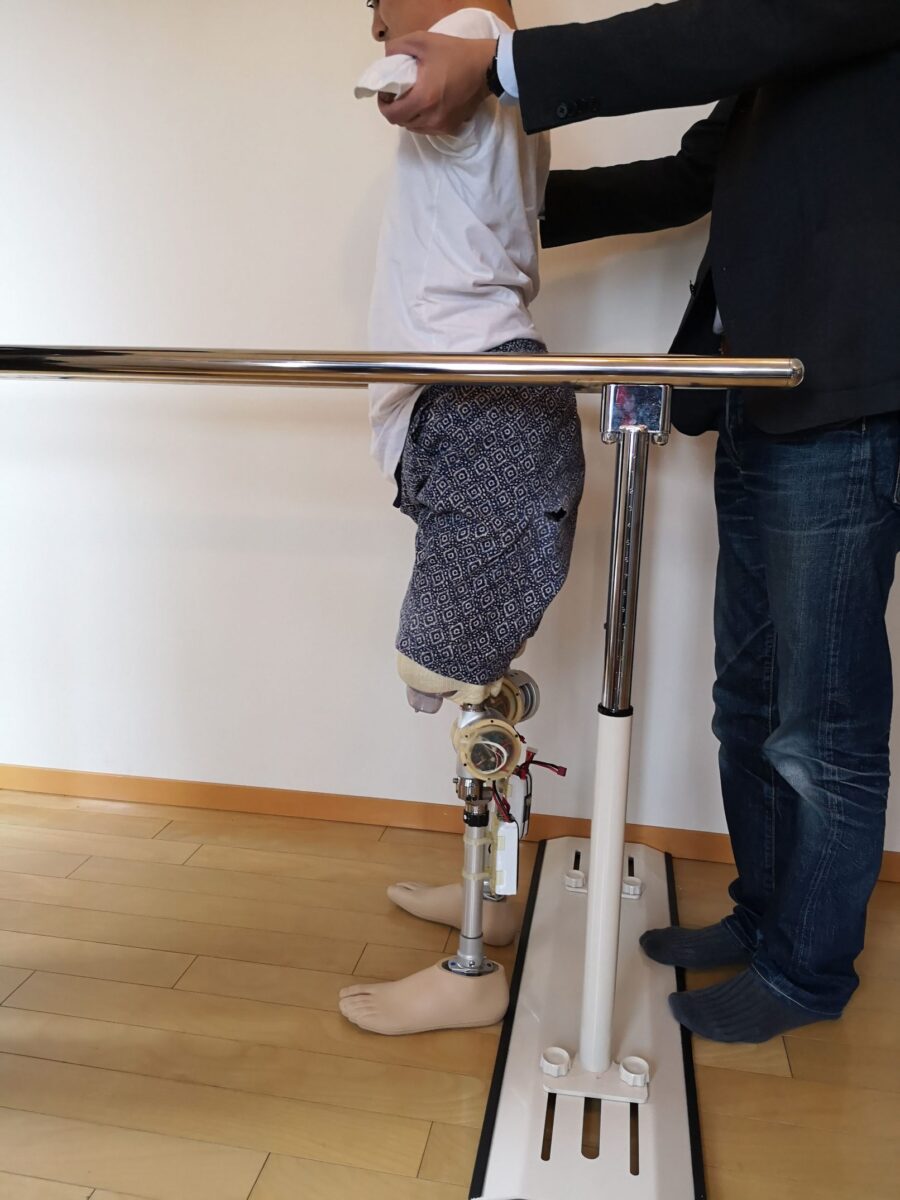-

- SHOEBILL by sony CSL
- prosthetic leg
- Hirotada Ototake
sony CSLの開発するロボット義足「SHOEBILL]を乙武氏の両足に装着できるようにカスタマイズしたものです。
パラリンピックが近づき義足自体を目にする機会は増えてきてはいるものの、まだまだ義足を使って歩くということが難しい人々は多いのが現状です。そこで乙武さんには、義足をつけて歩くには最も難易度が高い具体的な対象として協力していただいています。両手両足がない方が膝機構付きのロボット義足をつけて歩くのは世界でも今まで見たことがない非常にハードルの高いチャレンジです。
このプロジェクトで乙武さんの努力と、最新義足のテクノロジーを掛け合わせた結果歩くことができれば、子供たちが未来にもっとワクワクできたり、多くの方が希望を持ってくれるはずです。
デザインに関しては乙武さんは普段両足がない状態で生活しているため基本的に直立姿勢になることはなく、常に座位の状態です。そのため義足をつけて立ち上がろうとしたときには前傾姿勢になってしまいます(長く椅子に座る作業をする人が慢性的に腰が反っている状態になってしまうと似ています)
そうすると重心位置が前になって前方へ倒れやすくなるため、膝付きの義足の場合膝折れ(膝カックン)が起きやすくなってしまいます。また両手がない乙武さんは受け身をとることも難しいので安全性を考慮し膝折れが起きにくいよう膝の回転軸は普通の人の立位と比べて後ろ側につけています。
膝が後ろ側になるということは見た目は人の体とは少し違う足になってしまいます(それはそれで草食動物の足みたいになってかっこいいんですが)
しかし今回は人の足のシルエットを大事にしたいと考えていました。
それは乙武さんが今までなかった足を手に入れて、今後は長ズボンを履いたり、好きなスニーカーを選ぶなんていう当たり前に私たちがやっている日常ができるようになるということは、義足を使って「歩く」ということと同じくらい大事なことだと思っているからです。
これは私が義手をやっていたころから、すべての「モノ」のデザインに対して変わらず大事だと考えていることの一つですが、義肢や生活に使う「モノ」はあくまで道具で、大事なのはそれを使うことで日常をもっといい状態にすることができるということです。義足で言えばこの義足を使うことで日常をもっと楽しく(もっと言えば健常者よりも楽しく!)できるということです。
この義足はシルエットを人の体に近づけるため、従来ふくらはぎ部分にあったバッテリーをスネ側にレイアウト変更しました。できるだけ全体のシルエットは前に移動させ、膝の回転中心もぱっと見で前側に見えるようにデザインしています。そうすることで膝が後ろ側にある不自然さを解消し人のシルエットに近づけています。シルエットを人の足に似せているだけではなく、健常者にはできない自分の足の外装を簡単に取り外しができて外装のカスタムができるようにしていたり、装着するだけで美しいラインの足が手に入ったり、使う人がワクワクできる「モノ」として魅力的なデザインになるよう心がけています。将来的には乙武さんが今163㎝の伸長を暫定で設定していますが習熟度が上がれば身長を伸ばしていくことだって可能です。
これから乙武さんが歩くことがどんどんうまくなっていってこれからの未来の一つの形を示してくれればと願っています。

The robotic prosthetic leg “SHOEBILL” developed by Sony CSL has been customized to fit Mr. Hirotada Ototake’s legs.
As the Paralympics approach, prosthetic legs are becoming more visible, but many people still face challenges in walking with them. Mr. Ototake is participating in this project as one of the most challenging cases for using prosthetic legs. Having no arms and legs makes it extremely difficult to walk with robotic prosthetic legs that have knee mechanisms, something rarely seen in the world so far. This is an exceptionally high hurdle to overcome.
If, through this project, we can combine Mr. Ototake’s efforts with cutting-edge prosthetic technology to achieve walking, it will inspire children to look forward to the future with excitement and give many people a sense of hope.
Regarding the design, since Mr. Ototake lives his daily life without legs, he typically does not maintain an upright posture and remains seated most of the time. When he attempts to stand up with prosthetic legs, his posture becomes forward-leaning (similar to how people who spend a long time sitting tend to develop a habit of arching their backs).
This forward shift in the center of gravity makes him prone to tipping forward, and with prosthetic legs that have knee joints, this can lead to knee buckling. Additionally, since Mr. Ototake has no hands, he cannot brace himself for falls. Therefore, for safety, the knee joint’s rotational axis has been moved further back compared to where it would be for a typical person standing upright.
Having the knee joint positioned further back makes the legs look slightly different from a human’s (which, on the bright side, resembles the legs of herbivorous animals and looks quite cool). However, in this project, we wanted to maintain the silhouette of human legs.
This is because, after gaining legs that he never had before, the ability for Mr. Ototake to wear long pants and choose his favorite sneakers, just as we do every day, is just as important as the ability to walk with prosthetic legs. I believe that these aspects of everyday life are just as significant.
This is a principle I’ve held since my days working on prosthetic arms—that the design of every “thing” is important, but what matters most is improving the quality of life through its use. In the case of prosthetic legs, they should make daily life more enjoyable (even more enjoyable than for able-bodied people!).
To achieve a human-like silhouette, we repositioned the battery from the calf area to the front of the shin. We also shifted the overall silhouette forward, making the knee’s rotational center appear more natural at a glance, aligning with a human-like design. This approach resolves the unnatural appearance of having the knee placed further back and brings the silhouette closer to a human’s.
Not only is the prosthetic leg designed to resemble a human leg, but it also allows users to easily remove the exterior cover and customize it. The design is focused on making the prosthetic an exciting “thing” that can give the user beautifully shaped legs just by wearing it. Additionally, once Mr. Ototake masters using the prosthetic legs, he could potentially increase his height beyond the current temporary setting of 163 cm.
We hope that as Mr. Ototake continues to improve his walking skills, he will demonstrate one of the many possibilities for the future.



